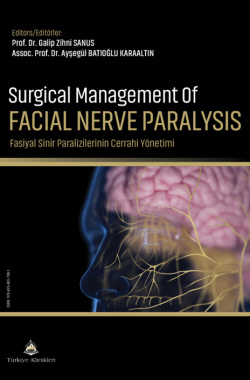Facial Nerve Evaluation: Topodiagnostic Tests and Grading Methods
İrfan PAPİLAa, Doğan ÇAKANa
aİstanbul University-Cerrahpaşa, Cerrahpaşa Faculty of Medicine, Department of Otorhinolaryngology, İstanbul, Türkiye
Papila İ, Çakan D. Facial nerve evaluation: Topodiagnostic tests and grading methods. In: Sanus GZ, Batıoğlu Karaaltın A, eds. Surgical Management of Facial Nerve Paralysis. 1st ed. Ankara: Türkiye Klinikleri; 2022. p.30-6.
ABSTRACT
Peripheral facial paralysis is the most common paralysis of the cranial nerves. Therefore, while it is clinically important, it is also very important for research. Grading systems are designed for the standardization and are used in the diagnosis and management of diseases. They also play a key role in scientific studies and literature research. The facial nerve has intracranial, intratemporal, and extratemporal parts. All these parts are affected to varying degrees by various diseases. The tests used to detect the affected parts and to predict the clinical course of the disease are called topodiagnostic tests. Various grading systems and topodiagnostic tests related to the facial nerve have been reported in previous studies. In this chapter, we will consider the most frequently used ones.
Keywords: Facial nerve; facial paralysis/diagnosis; facial paralysis/classification; prognosis
Kaynak Göster
Referanslar
- Atolini Junior N, Jorge Junior JJ, Gignon VF, Kitice AT, PradoLSA, Santos VGW. Facial nerve palsy: incidence of different ethiologies in a tertiary ambulatory. Arq Int Otorrinolaringol.2009;13(2):167-71.
- Ziahosseini K, Nduka C, Malhotra R. Ophthalmic grading of facial paralysis: need for a closer look. Br J Ophthalmol. 2015;99(9):1171-5. [Crossref] [PubMed]
- Standring S, Borley NR, Collins P, Crossman AR, Gatzoulis MA, HealyJC. Face and Scalp. In: Standring S, ed. Gray's anatomy. 40th ed. Spain:Churchill Livingstone elsevier; 2008. p. 467-97.
- House JW. Facial nerve grading systems. Laryngoscope.1983;93(8):1056-69. [Crossref] [PubMed]
- House JW, Brackmann De. Facial nerve grading system. OtolaryngolHead Neck Surg. 1985;93(2):146-7. [Crossref] [PubMed]
- Yen TL, Driscoll CL, Lalwani AK. Significance of House-Brackmann facial nerve grading global score in the setting of differential facial nervefunction. Otol Neurotol. 2003;24(1):118-22. [Crossref] [PubMed]
- Brenner MJ, Neely JG. Approaches to grading facial nerve function.Semin Plast Surg. 2004;18(1):13-22. [Crossref] [PubMed] [PMC]
- Murty Ge, Diver JP, Kelly PJ, O'Donoghue GM, Bradley PJ. The Nottingham System: objective assessment of facial nerve function in theclinic. Otolaryngol Head Neck Surg. 1994;110(2):156-61. [Crossref] [PubMed]
- Ross BG, Fradet G, Nedzelski JM. Development of a sensitive clinical facial grading system. Otolaryngol Head Neck Surg. 1996;114(3):380-6. [Crossref]
- Hu WL, Ross B, Nedzelski J. Reliability of the Sunnybrook Facial Grading System by novice users. J Otolaryngol. 2001;30(4):208-11. [Crossref] [PubMed]
- Kayhan FT, Zurakowski D, Rauch SD. Toronto Facial Grading System:interobserver reliability. Otolaryngol Head Neck Surg. 2000;122(2):212-5. [Crossref] [PubMed]
- Berg T, Jonsson L, engström M. Agreement between the sunnybrook,house-brackmann, and yanagihara facial nerve grading systems in bell'spalsy. Otol Neurotol. 2004;25(6):1020-6. [Crossref] [PubMed]
- Kanerva M, Jonsson L, Berg T, Axelsson S, Stjernquist-Desatnik A, engström M, et al. Sunnybrook and House-Brackmann systems in 5397facial gradings. Otolaryngol Head Neck Surg. 2011;144(4):570-4. [Crossref] [PubMed]
- Yildiz S, Bademkiran F, Yildiz N, Aydogdu I, Uludag B, ertekin C. Facialmotor cortex plasticity in patients with unilateral peripheral facial paralysis. NeuroRehabilitation. 2007;22(2):133-40. [Crossref] [PubMed]
- Vrabec JT, Backous DD, Djalilian HR, Gidley PW, Leonetti JP, Marzo SJ,et al; Facial Nerve Disorders Committee. Facial nerve grading system2.0. Otolaryngol Head Neck Surg. 2009;140(4):445-50. [Crossref] [PubMed]
- Lee HY, Park MS, Byun JY, Chung JH, Na SY, Yeo SG. Agreement between the facial nerve grading system 2.0 and the house-brackmanngrading system in patients with bell palsy. Clin exp Otorhinolaryngol.2013;6(3):135-9. [Crossref] [PubMed] [PMC]
- May M. Anatomy, physiology, and testing of the facial nerves. In: Brackmann De, ed. Neurogical Surgery of the ear and Skull Base. 1st ed. NewYork: Raven Press; 1982.
- Bayındır T, Tan M, Selimoglu e. [Diagnosis and management of bellpalsy]. KBB-Forum. 2011;10(1):18-30.
- Lalwani AK, Butt FY, Jackler RK, Pitts LH, Yingling CD. Facial nerve outcome after acoustic neuroma surgery: a study from the era of cranialnerve monitoring. Otolaryngol Head Neck Surg. 1994;111(5):561-70. [Crossref] [PubMed]
- Hughes GB. Practical management of Bell's palsy. Otolaryngol HeadNeck Surg. 1990;102(6):658-63. [Crossref] [PubMed]
- Cummings CV, Filint PW, Harker LA, Haughey DH, Richardson MA, Robbins KT, et al; eds. Koc C, çeviri editörü. Cummings OtolaringologolojiBaş ve Boyun Cerrahisi. 4. Baskı. İstanbul: Güneş Tıp Kitabevleri; 2007.p.3333-49.
- Saito H, Higashitsuji H, Kishimoto S, Miyamoto K, Kitamura H. Submandibular salivary pH as a diagnostic aid for prognosis of facial palsy.Laryngoscope. 1978;88(4):663-6. [Crossref] [PubMed]
- Ikeda M, Abiko Y, Kukimoto N, Omori H, Nakazato H, Ikeda K. Clinicalfactors that influence the prognosis of facial nerve paralysis and the magnitudes of influence. Laryngoscope. 2005;115(5):855-60. [Crossref] [PubMed]
- Guntinas-Lichius O, Volk GF, Olsen KD, Mäkitie AA, Silver Ce, ZafereoMe, et al. Facial nerve electrodiagnostics for patients with facial palsy:a clinical practice guideline. eur Arch Otorhinolaryngol.2020;277(7):1855-74. [Crossref] [PubMed] [PMC]
- Sittel C, Stennert e. Prognostic value of electromyography in acute peripheral facial nerve palsy. Otol Neurotol. 2001;22(1):100-4. [Crossref] [PubMed]
- Happe S, Bunten S. electrical and transcranial magnetic stimulation ofthe facial nerve: diagnostic relevance in acute isolated facial nerve palsy.eur Neurol. 2012;68(5):304-9. [Crossref] [PubMed]
- Schriefer TN, Mills KR, Murray NM, Hess CW. evaluation of proximal facial nerve conduction by transcranial magnetic stimulation. J Neurol Neurosurg Psychiatry. 1988;51(1):60-6. [Crossref] [PubMed] [PMC]

